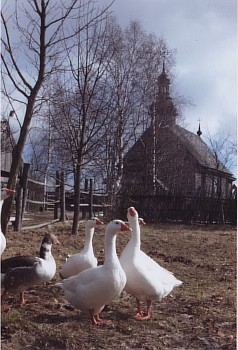
| Science Culture Cooperation Library Multimedia |
|
Main - - Culture - Architectural monuments - Minsk region The Belarusian State Museum of Folk Architecture and Life
The Belarusian State Museum of Folk Architecture and Life. It was founded in 1976 twelve kilometres to the south-west of Minsk near Volchkovichi reservoir at the confluence of the Ptich and the Menka rivers, between the villages of Ozertso, Volchkovichi, Gorodishche and Strochitsa. This is a unique museum complex, which today is the largest one in the museification of folk architecture and life. It is based on territorial and ethnographic, functionally subordinate, historical and social principles. The peculiarities of the territory and the presence of historical monuments ( an ancient settlement on the Menka, mounds of the 9th-11th centuries, an ancient village of Strochitsa with its traditional structure and estates) defined the concept of the museum as a national architectural and ethnographic Park and Reserve. At present, the Belarusian Skansen covers an area of 154 hectares, on which the three exhibition sectors are located: Central Belarus, Lakeland and Podneprovye, not completely rebuilt. 16 monuments of folk architecture are located in the sector of Central Belarus "(Intercession Church of the 18th century from the village of Lognovichi, Kletsk district; the school of the beginning of the 20th century from the village of Kolodchino , Vilejka district; the community barn of the 19th century from the village of Kosarichi, Glusk district; the tavern of the 19th century from the village of Hvoevo, Nesvizh district; the estates with residential and economic buildings of the early 20th century from the village of Iserno and Ogorodniki, Slutsk district, Sadovichi, Kopyl district , Zabrodye, Stolbtsy district; the blacksmith shop of the beginning of the 20th century from the village of Klochkovo, Molodechno district and a windmill of the beginning of the 20th century from the village of Domotkanovichi, Kletsk district), five in Lakeland "(among them the Transfiguration Church of the beginning of the18th century from the village of Baran, Orsha district, the estates of the beginning of the 20th century from the villages of Volevo and Brakova Sloboda Dubrouna and Chaussy districts, the windmill of the beginning of the 20th century from the village of Zieleniec, Khotimsk district), 11 in the "Lakeland" (the church and the Bell Tower of the18th century from the village of Velets, Glubokoe district, the estate from the village of Timoshkovo, Miory district, Budichi, Dokshitsy district, Voroshilki, Miadzel district, barn-floor buildings from the villages of Leonovichi, Postavy district, Kemyantsy, Braslav district, Volkovschina, Miory district ,the windmill from the village of Yanushovka, Miadzel district). The unique object that has been moved is the chapel of the beginning of the 19.-th century from the village of Korolevtsy, Vilejka district. Besides, there is a house on display from the beginning of the 20th century from 4, Osvobozhdeniya street of Minsk in the place of a new sector of wooden suburbs of towns,planned for 1992-1993.
© National Academy of Sciences of Belarus, 2011
|

